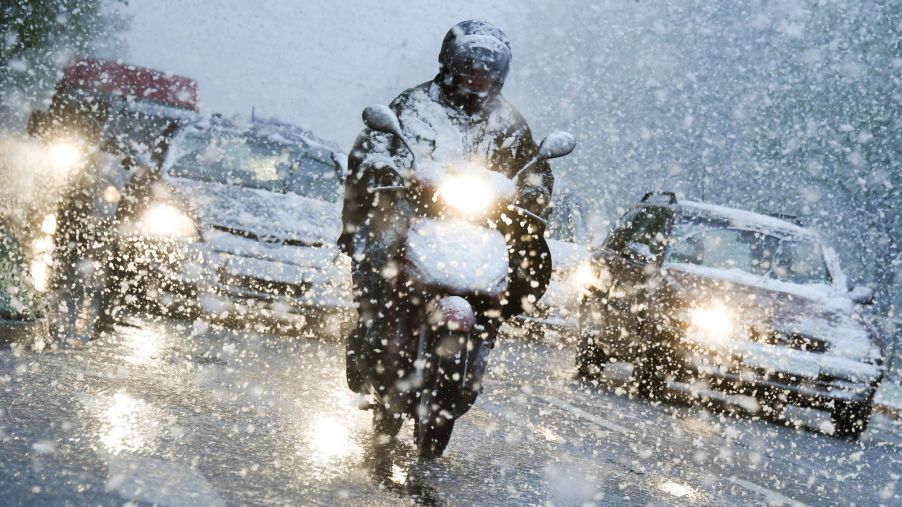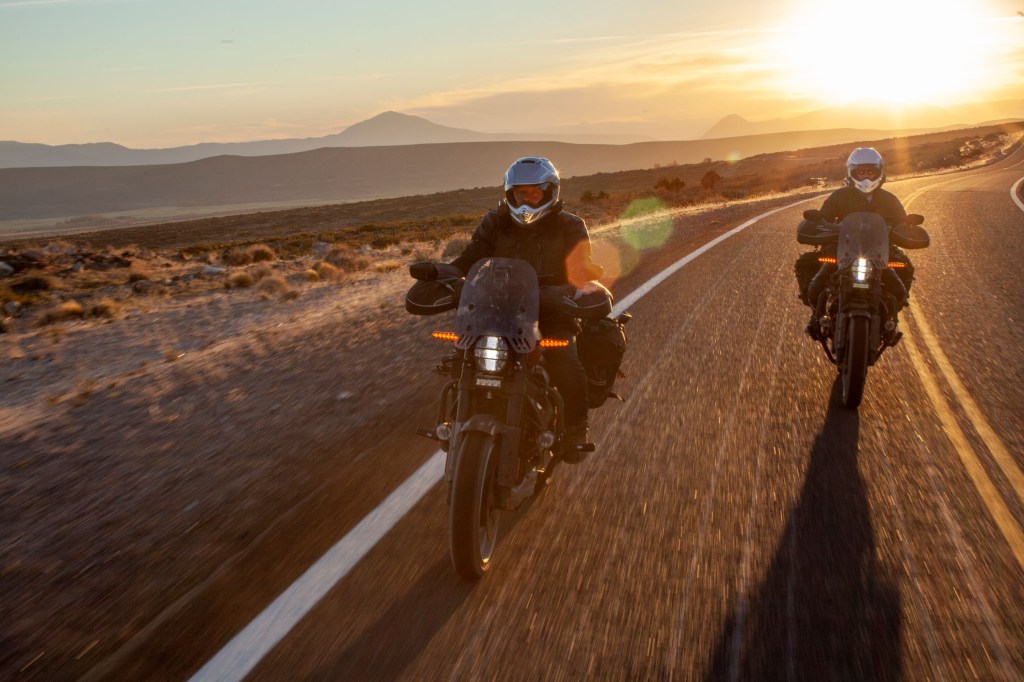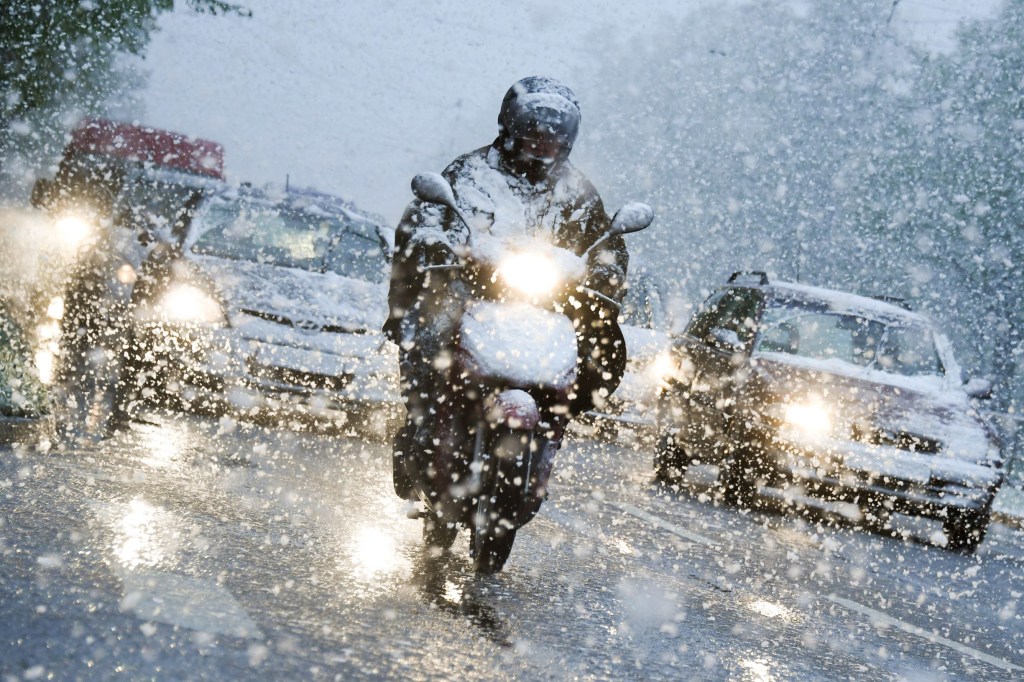
How Do You Keep Warm While Riding a Motorcycle?
Winter, or at least the onset of cold weather, usually spells the end of motorcycle season. But some continue to brave the icy landscape regardless, especially if there’s little-to-no snow. And even when spring comes, the chill lingers for some time. So, it’s crucial for motorcycle riders to have cold-weather gear and know how to use it.
Cold-weather motorcycle riding starts with personal gear layering
It doesn’t have to be fully winter for cold-weather motorcycle gear to be vital. That’s because riding a bike at speed strips heat faster than if you were just sitting in place. That’s due to the convective heat transfer associated with wind chill, BikeBandit explains. And it can be more drastic than you think.
Riding at 45 mph on a 50°F day makes it feel as if it’s 40°F. And on a 40°F day, 45 mph makes it feel like it’s 26°F. Hence why winter and cold-weather riding requires careful motorcycle gear prep.
That begins with layering, especially around your core, The Drive and Outside report. Your body naturally shuts off blood flow to your extremities as you get cold to keep your core organs warm. The more warmth you retain there, the easier it is to keep your fingers and toes warm. But if you get too warm, you start sweating, which makes you cool off, Outside explains.
That’s why an effective winter motorcycle gear strategy incorporates multiple layers. Start with a wool or synthetic base layer that wicks sweat away from the body, REI explains. Next, an insulating middle layer, which can be a heated vest or liner, Motorcyclist reports. On top of that, an outer wind- and water-repelling jacket, which often has its own liner, The Drive reports. Plus, a balaclava or similar item for your head and face, Cycle World reports.
Speaking of heated gear, many motorcyclists turn to heated gloves for winter and cold-weather riding, The Drive reports. Like the vests, often these gloves are wired into the bike’s electrical system, or plugged into an outlet. However, there are now long-lasting battery-operated heated gloves available.
Unfortunately, heated winter motorcycle boots aren’t really a thing. However, there are several insulated, water-repelling, armored boots available, Motorcyclist reports. And you’ll want to wear some thick socks, preferably several pairs, with at least one woolen one. Luckily, you can buy heated socks, RideApart reports.
Your motorcycle needs its own winter gear, too
Gloves and liners aren’t the only heated gear available for cold-weather motorcycle riding, though. Many bikes, especially touring and adventure bikes, come standard with heated grips, or at least pre-wired for them. And a few higher-end models are starting to offer heated seats, too.

A great way to prevent the winter wind from stealing your heat is to stop it from ever reaching you. Which, for motorcycle riders, means larger windshields and protective handguards, Jalopnik reports. There are even insulated windproof hand covers that wrap completely around the levers and grips, RideApart reports. Ewan McGregor and Charley Boorman used them on their Harley-Davidson LiveWires during Long Way Up filming.
Finally, as with cars, riding your motorcycle in the winter is easier with a proper winter tire. Even if your local area doesn’t see snow, cold temperatures require special rubber compounds to maintain proper levels of grip. At the very least, make sure your bike’s tires are relatively new, have plenty of tread life, and are at the correct pressure, RideApart reports.
Other useful riding tips
As with glasses and face masks, riding a motorcycle in the winter means foggy lenses. But there are anti-fog sprays and cleaners available, Cycle World reports, and convenient wipes, Motorcyclist reports. Similarly, winter road conditions often create sprays of dirty water, ice, and salt, clouding your field of view. One solution is to spray a water repellant like Rain-X on your visor.
Those sprays can also play havoc with your motorcycle’s components, Motorcyclist reports. Dirt clogs up air filters; salt corrodes metal and ages rubber. So, if you’re riding in these conditions, you’ll have to clean and maintain your bike more frequently.

Finally, with cold-weather motorcycle riding, as with any riding, especially in wet conditions, know your limits. Slow down, keep a weather eye out for road hazards, such as slippery oil and water, Cycle World explains. Make sure to move your fingers and toes from time to time to keep warm blood flowing. And if you find yourself shivering even with all your heated gear and wind protection, it’s too cold to ride, RideApart reports.
Follow more updates from MotorBiscuit on our Facebook page.


